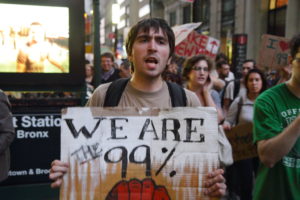Credit Occupy in Bernie Sanders’ Surge
What began in 2011 as a movement against income inequality has morphed into burgeoning support for a presidential candidate who is passionate about economic justice. Occupy Los Angeles protesters rally in 2011. (shalunts / Shutterstock)
Occupy Los Angeles protesters rally in 2011. (shalunts / Shutterstock)
For insight into Bernie Sanders’ unexpected surge, go back to 2011, to the then-scorned Occupy Wall Street movement and its drive against the 1 percent and income inequality.
Written off that year as disorganized and ineffective, the Occupy movement has contributed volunteers and — even more important—its powerful message to Sen. Bernie Sanders’ presidential campaign. The combination of progressive volunteers and a powerful attack on economic injustice helped Sanders come extremely close to beating Hillary Clinton in Iowa and could be of great help to him in the New Hampshire primary on Tuesday.
Sanders is favored to win in New Hampshire, a neighbor to his home state of Vermont. He has a substantial lead in public opinion polls. But polls aren’t reliable predictors. In 2008, Clinton staged a furious comeback in the New Hampshire primary and beat Barack Obama there.
“The Occupy movement set the stage for the Sanders campaign,” Lauren Steiner, an Occupy veteran, told me in a phone interview. She is lead organizer for Los Angeles for Bernie, a coalition of more than 30 grass-roots groups. She arranged for former Labor Secretary Robert Reich, now a professor at the University of California, Berkeley, to speak at an Occupy Los Angeles teach-in at the group’s City Hall encampment in 2011.
“Even though the Occupy Wall Street movement isn’t occupying parks or buildings anymore, its legacy remains,” said Peter Dreier, an Occidental College professor and a well-known scholar of progressive politics and urban affairs.
He said in an email to me, “Everyone in America now knows what ‘the 1 percent’ and ‘99 percent’ means. Public opinion polls show that a vast majority of Americans think that big corporations have too much political influence, that the super-rich don’t pay their fair share of taxes, that the government should have stronger regulations on Wall Street and even break up the big banks, and that we should raise the minimum wage to $15 an hour.”
“All this laid the groundwork for Bernie Sanders’ campaign,” Dreier wrote, “and this is why Sanders’ ideas are resonating with so many Americans.”
Reporting from Des Moines, Iowa, on Monday, the Los Angeles Times’ Kate Linthicum wrote, “In Iowa this week, former Occupy protesters could be found easily among Sanders’ volunteers, knocking on doors and dialing voters to drive Sanders supporters to Monday’s caucus.”
Los Angeles organizer Steiner said the Sanders’ campaign “is very similar to Occupy, decentralized.” Nobody waits for permission to hold events, she said.
I got the same description when I talked to the co-founder and state director of the group Illinois for Bernie Sanders. The organizer, who goes by the name “Jackrabbit,” also helps run its website, one of many across the country. He told me, “People feel they can plug in and be a real part of it.”
“The people feel as though they are part of the Bernie Sanders campaign by participating, doing phone-banking, doing [debate] watch parties. These people feel — rightly so — they are part of his political campaign and part of his political revolution,” Jackrabbit said. He had joined Occupy Wall Street when it began in Zuccotti Park in New York in 2011.
I saw the very beginnings of this in that fall when I began visiting the Occupy L.A. encampment. It sprawled over City Hall’s lawns, within walking distance of the downtown banks where the Occupiers held protests. The disorganization put me off at first, as did the Occupiers’ disinclination to talk to reporters. But I learned to stick my notebook in a pocket and eavesdrop as Occupiers planned and argued. Occasionally, I’d walk away to write my notes.
One day, I listened to a small meeting at which a dozen or more people were discussing how and how often to serve food. They argued over serving hours, menus (one person was a vegan, another loved protein), and who would cook and serve.
“Interesting, isn’t it,” said a friend, Art Goldberg. He’s a lawyer who was one of the most famous leaders of the Berkeley Free Speech Movement in the mid-1960s and has been protesting ever since. He stopped by the encampment every day during breaks in trial at the nearby courthouse.
“If you’re interested in food service,” I replied sarcastically. He said I didn’t understand what I was seeing. They weren’t just arguing about food. If I had listened carefully, I would have understood they were talking about the essentials of political organizing—communicating, assigning tasks, scheduling, motivating, and making everyone feel they are part of an important effort.
After the meeting, a young woman came over to talk to Goldberg. He talked to her about the need to work out the differences. She said she was trying to mediate between two strong women, one who cooked and the other who served. I could see what was really involved at the meeting I had observed: leadership and bringing people together, the essentials of both serving dinner and running a campaign.
And so it was when Hurricane Sandy struck the Northeast in 2012. Jackrabbit, the Zuccotti Park veteran, explained how Occupy Wall Street people began Occupation Sandy. “It was created to provide a relief by people who knew each other through Occupy. They went to affected areas and put together a disaster relief and recruited hundreds of people to provide relief.
“It was like the Sanders campaign. It was an opportunity for people to plug in and make a difference.”
As The New York Times reported at the time, “In the past two weeks, Occupy Sandy has set up distribution sites at a pair of Brooklyn churches where hundreds of New Yorkers muster daily to cook hot meals for the afflicted and to sort through a medieval marketplace of donated blankets, clothes and food. There is an Occupy motor pool of borrowed cars and pickup trucks that ferries volunteers to ravaged areas. An Occupy weatherman sits at his computer and issues regular forecasts. Occupy construction teams and medical committees have been formed.”
The Sanders campaign is another step in the political evolution of the Occupy Wall Street veterans and those who sympathize with them. When the movement started, most of them scorned politics and politicians. In 2012, I attended a Saturday afternoon meeting at a church where they heaped abuse on an elected official who actually was sympathetic to Occupy’s goals. “We don’t want to join with any group affiliated with the electoral system,” said one of the Occupy attendees.
Now some of them are giving elections—or at least Sanders’ political revolution—a chance. If that continues, Occupy, once the foe of electoral politics, will provide a valuable boost to a Sanders campaign battling to withstand the Clinton assault.
Your support matters…Independent journalism is under threat and overshadowed by heavily funded mainstream media.
You can help level the playing field. Become a member.
Your tax-deductible contribution keeps us digging beneath the headlines to give you thought-provoking, investigative reporting and analysis that unearths what's really happening- without compromise.
Give today to support our courageous, independent journalists.






You need to be a supporter to comment.
There are currently no responses to this article.
Be the first to respond.